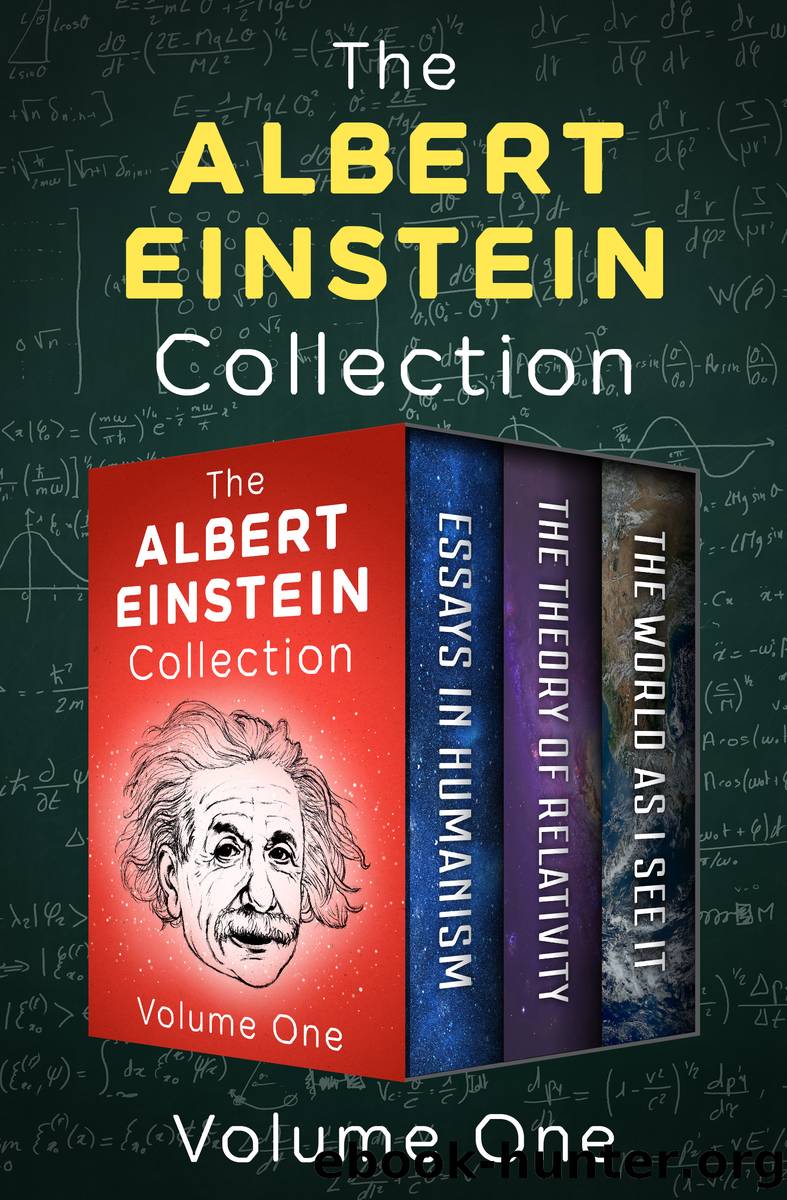The Albert Einstein Collection Volume One by Albert Einstein

Author:Albert Einstein
Language: eng
Format: epub
Publisher: Philosophical Library/Open Road
Published: 2008-05-31T00:00:00+00:00
THE FIELD CONCEPT
In explaining optical and electrical phenomena Newtonâs mechanics has been far less successful than it had been in the fields cited above. It is true that Newton tried to reduce light to the motion of material points in his corpuscular theory of light. Later on, however, as the phenomena of polarization, diffraction and interference of light forced upon his theory more and more unnatural modifications, Huyghensâ undulatory theory of light, prevailed. Probably this theory owes its origin essentially to the phenomena of crystallographic optics and to the theory of sound, which was then already elaborated to a certain degree. It must be admitted that Huyghensâ theory also was based in the first instance upon classical mechanics; but, the all-penetrating ether had to be assumed as the carrier of the waves and the structure of the ether, formed from material points, could not be explained by any known phenomenon. One could never get a clear picture of the interior forces governing the ether, nor of the forces acting between the ether and the âponderableâ matter. The foundations of this theory remained, therefore, eternally in the dark. The true basis was a partial differential equation, the reduction of which to mechanical elements remained always problematic.
For the theoretical conception of electric and magnetic phenomena one introduced, again, masses of a special kind, and between these masses one assumed the existence of forces acting at a distance, similar to Newtonâs gravitational forces. This special kind of matter, however, appeared to be lacking in the fundamental property of inertia; and, the forces acting between these masses and the ponderable matter remained obscure. To these difficulties there had to be added the polar character of these kinds of matter which did not fit into the scheme of classical mechanics. The basis of the theory became still more unsatisfactory when electrodynamic phenomena became known, notwithstanding the fact that these phenomena brought the physicist to the explanation of magnetic phenomena through electrodynamic phenomena and, in this way, made the assumption of magnetic masses superfluous. This progress had, indeed, to be paid for by increasing the complexity of the forces of interaction which had to be assumed as existing between electrical masses in motion.
The escape from this unsatisfactory situation by the electric field theory of Faraday and Maxwell represents probably the most profound transformation which has been experienced by the foundations of physics since Newtonâs time. Again, it has been a step in the direction of constructive speculation which has increased the distance between the foundation of the theory and what can be experienced by means of our five senses. The existence of the field manifests itself, indeed, only when electrically charged bodies are introduced into it. The differential equations of Maxwell connect the spacial and temporal differential coefficients of the electric and magnetic fields. The electric masses are nothing more than places of non-disappearing divergency of the electric field. Light waves appear as undulatory electromagnetic field processes in space.
To be sure, Maxwell still tried to interpret his field theory mechanically by means of mechanical ether models.
Download
This site does not store any files on its server. We only index and link to content provided by other sites. Please contact the content providers to delete copyright contents if any and email us, we'll remove relevant links or contents immediately.
| Deconstruction | Existentialism |
| Humanism | Phenomenology |
| Pragmatism | Rationalism |
| Structuralism | Transcendentalism |
| Utilitarianism |
The remains of the day by Kazuo Ishiguro(8817)
Tools of Titans by Timothy Ferriss(8213)
Giovanni's Room by James Baldwin(7188)
The Black Swan by Nassim Nicholas Taleb(7010)
Inner Engineering: A Yogi's Guide to Joy by Sadhguru(6722)
The Way of Zen by Alan W. Watts(6504)
Asking the Right Questions: A Guide to Critical Thinking by M. Neil Browne & Stuart M. Keeley(5631)
The Power of Now: A Guide to Spiritual Enlightenment by Eckhart Tolle(5604)
The Six Wives Of Henry VIII (WOMEN IN HISTORY) by Fraser Antonia(5394)
Astrophysics for People in a Hurry by Neil DeGrasse Tyson(5130)
Housekeeping by Marilynne Robinson(4334)
12 Rules for Life by Jordan B. Peterson(4249)
Double Down (Diary of a Wimpy Kid Book 11) by Jeff Kinney(4204)
The Ethical Slut by Janet W. Hardy(4172)
Skin in the Game by Nassim Nicholas Taleb(4161)
Ikigai by Héctor García & Francesc Miralles(4123)
The Art of Happiness by The Dalai Lama(4063)
Skin in the Game: Hidden Asymmetries in Daily Life by Nassim Nicholas Taleb(3929)
Walking by Henry David Thoreau(3892)
